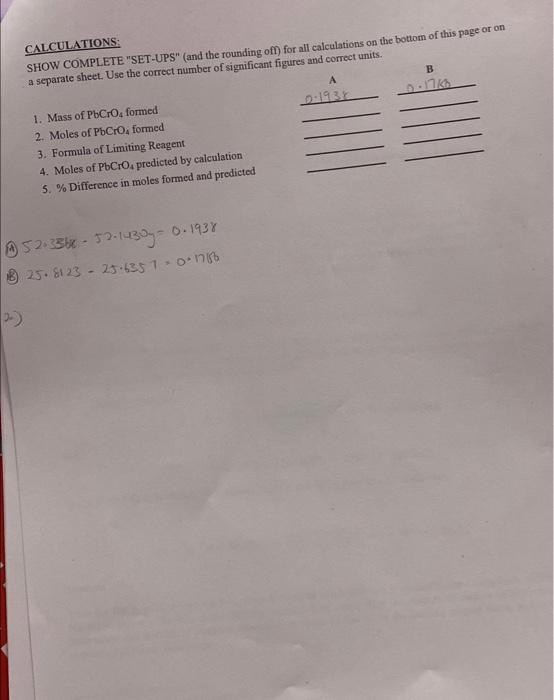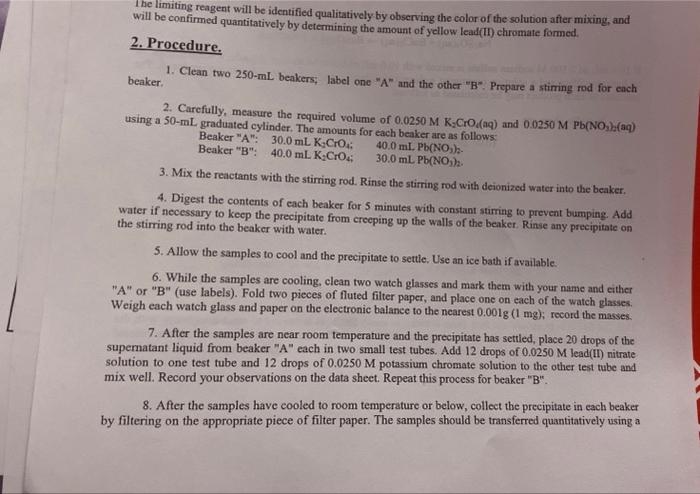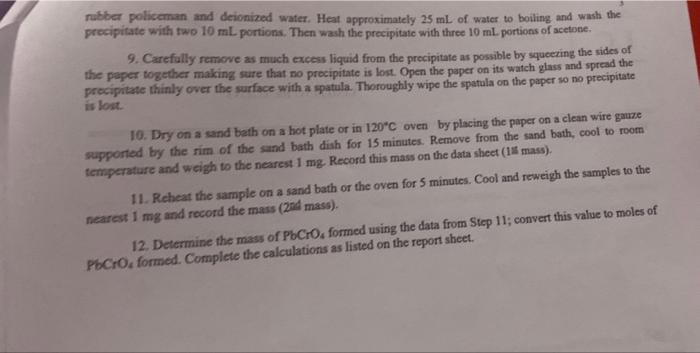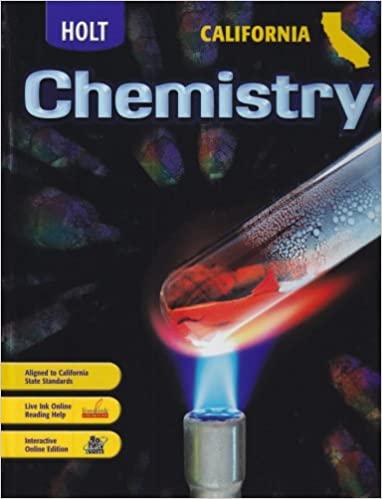Answered step by step
Verified Expert Solution
Question
1 Approved Answer
May I please get some help OBSERVATIONS: Record your observations after testing the supematant liquid with both reagents. Briefly, indicate the significance of these tests.
May I please get some help 



OBSERVATIONS: Record your observations after testing the supematant liquid with both reagents. Briefly, indicate the significance of these tests. Use completo Eaglish sentences. CALCULATIONS: e:INW COMPLETE "SET-UPS" (and the rounding off) for all calculations on the bottom of this page or on The limiting reagent will be identified qualitatively by observing the color of the solution after mixing, and will be confirmed quantitatively by determining the amount of yellow lead(II) chromate formed. 2. Procedure. 1. Clean two 250mL beakers; label one "A" and the other "B". Prepare a stining rod for each beaker. 2. Carefully, measure the required volume of 0.0250MK2CrO4(aq) and 0.0250MPb(NO3) (aq) using a 50-mL graduated cylinder. The amounts for each beaker are as follows: 3. Mix the reactants with the stirring rod. Rinse the stirring rod with deionized water into the beaker. 4. Digest the contents of each beaker for 5 minutes with constant stiming to prevent bumping. Add water if necessary to keep the precipitate from ereeping up the walls of the beaker. Rinse any precipitate on the stiring rod into the beaker with water. 5. Allow the samples to cool and the precipitate to settle. Use an ice bath if available. 6. While the samples are cooling, clean two wateh glasses and mark them with your name and either "A" or "B" (use labels). Fold two pieces of fluted filter paper, and place one on each of the watch glasses: Weigh each wateh glass and paper on the electronic balance to the nearest 0.001g(1mg); record the masses. 7. After the samples are near room temperature and the precipitate has settled, place 20 drops of the supernatant liquid from beaker "A" each in two small test tubes. Add 12 drops of 0.0250M lead(II) nitrate solution to one test tube and 12 drops of 0.0250M potassium chromate solution to the other test tube and mix well. Record your observations on the data sheet. Repeat this process for beaker "B". 8. After the samples have cooled to room temperature or below, collect the precipitate in each beaker by filtering on the appropriate piece of filter paper. The samples should be transferred quantitatively using a nubber policeman and deionized water. Heat approximately 25mL of water to boiling and wash the precipitate with two 10mL portions. Then wash the precipitatc with three 10mL portions of acetone. 9. Carefully remove as much excess liquid from the precipitate as possible by squeexing the sides of the peper together making sure that no procipitate is lost. Open the paper on its watch glass and spread the precipitase thinly over the surfsce with a spatula. Thoroughly wipe the spatula on the paper so no precipitate is lost. 10. Dry on a sand bath on a hot plate or in 120C oven by placing the paper on a clean wire gauze supported by the rim of the sind bath dish for 15 minutes. Remove from the sand bath, cool to room temperature and weigh to the nearest 1mg. Recond this mass on the data sheet (1It mass). 11. Reheat the sample on a sand bath or the oven for 5 minutes. Cool and reweigh the samples to the nearest 1mg and rocord the mass (2nd mass). 12. Determine the mass of PbCrO4 formed using the data from Step 11; convert this value to moles of PbCrO4 formed. Complete the calculations as listed on the report sheet 



Step by Step Solution
There are 3 Steps involved in it
Step: 1

Get Instant Access to Expert-Tailored Solutions
See step-by-step solutions with expert insights and AI powered tools for academic success
Step: 2

Step: 3

Ace Your Homework with AI
Get the answers you need in no time with our AI-driven, step-by-step assistance
Get Started


